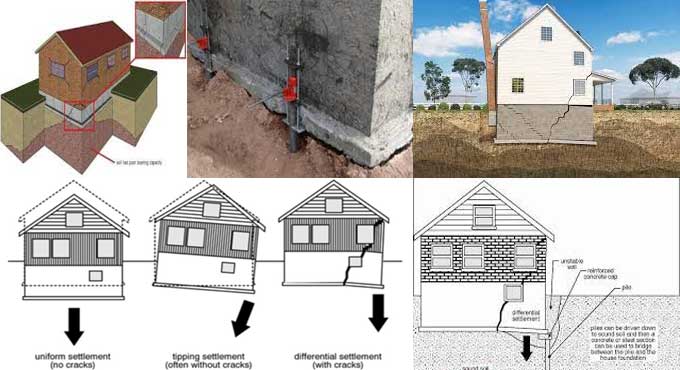
What do you need to know about Foundation Settlement?
Soils will inevitably flex under the weight of foundational constructions. Settlement is the collective vertical displacement that takes place at the foundation level. The decrease in the volume of air void ratio in the soil is the reason for the foundation settling.
The kinds of soil and foundation construction are two further elements that affect how much a foundation will sink. Bedrock-based foundations only slightly settle over time. Foundations in other types of soil, including clay, may, on the other hand, settle significantly more.
However, the amount of settlement in a building's foundation is often only measured in millimeters or fractions of an inch. Buildings will sustain damage from the settling of their foundation, especially if the settlement happens quickly.
This article will explore several foundation settlement types, their situations, and the consequences they are likely to have on the structure.
Types of settlements for foundation
Differential settlement type:
Different settlement refers to settling that happens at various speeds within a building. If there are variations in the soil, loads, or structural systems between different areas of a structure, differential settling will result. In this instance, the building structure's various components may settle by sustainability to varying degrees.
Due to this, the structure of the building may become distorted, the floors may slope, walls may crack, and the doors and windows may not operate properly; as a result, the frame of the building may become distorted.
It is possible for a structure to shift out of plumb due to uneven foundation settlement, which in turn can lead to cracks originating in the foundation, structure, or finish of the building. Most of the foundation failures can be attributed to severe differential settlements on the foundation.
Uniform settlement type:
It is known as uniform settling when the foundation settles at a pace that is essentially the same throughout the whole structure. Uniform settling is the type that is most likely to occur when a building's components are all supported by the same type of soil.
Similar to this, uniform type settlement would be expected if loads on the structure and the design of its structural system are consistent throughout. Universal settlement often has a little negative impact on building safety.
Nevertheless, it can have a significant impact on the utility of the building, as it can damage the sewer, the water supply, and the main drains, as well as jam the doors and windows.
Causes of Foundation Settlement
- Infiltration failure of deformable soil underneath.
- Yielding of the foundation's nearby excavation.
- Failure of mines and tunnels underground.
- The weight of the building, comprising both the dead load and the living load, is the direct cause of the foundation settling.
- Flooding causes the foundation to be undermined.
- The settlement brought on by an earthquake.
Preventions of Foundation Settlement
- Provide a foundation with minimal depth.
- Get rid of any tree roots that are under the foundation.
- Design a foundation that can support heavy loads that may be placed on the building.
- The best sort of foundation should be used in construction.
Components of Foundation Settlement
Immediate settlement component
It is also known as short-term settlement. Most immediate settling occurs in unsaturated fine-grained soils with low permeability and coarse-grained soils with high permeability. Finally, it only lasts for around 7 days and happens quickly. So it ends as it is being built.
Primary settlement component
Another name for it is primary consolidation. Inorganic fine-grain soil that has been wet typically experiences a primary settling. Primary settlement is caused by the water evaporating from saturated fine-grain soil's pores.
Secondary settlement component
The consolidation of soil under ongoing effective stress is known as secondary settlement. It often happens in organic fine-grain soil. Similar to creep in concrete, it occurs throughout the foundation structure's lifespan.
To get more details, watch the following video tutorial.
Video Source: CIVILERA


